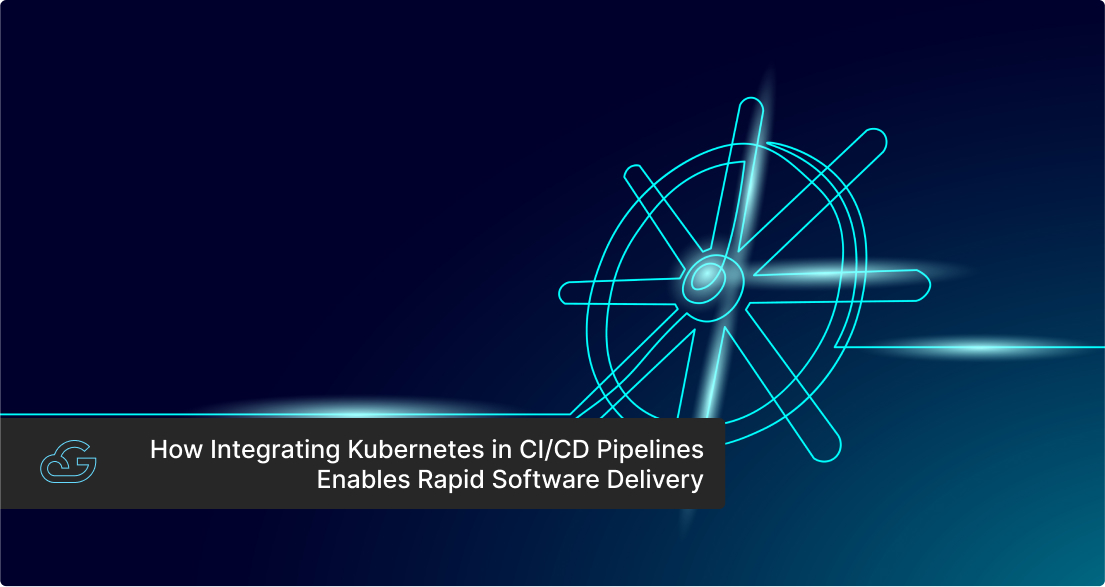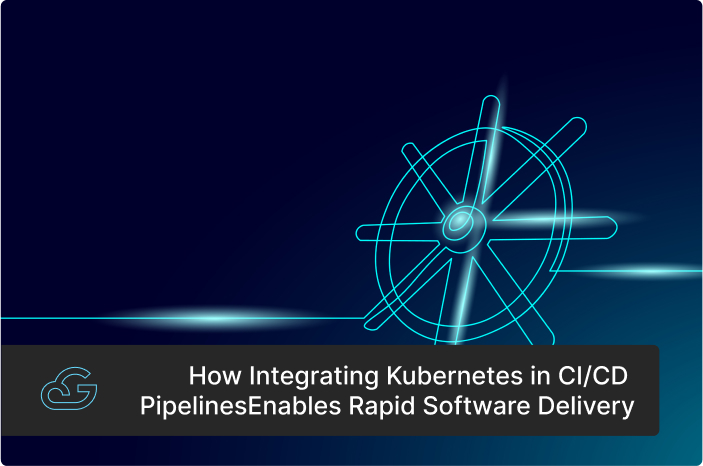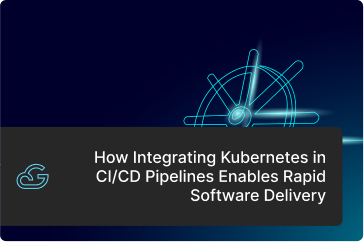Blogs / Kubernetes
How Integrating Kubernetes in CI/CD Pipelines Enables Rapid Software Delivery
By
Vineeth Babu
Posted: February 12, 2024
• 7 min 49 sec read
Success in the technology landscape is synonymous with agility. Enterprises, irrespective of their size, must be able to deliver products and services swiftly. Additionally, they must showcase the flexibility to respond quickly to changing market dynamics and evolving customer demands. For instance, companies like Netflix, Spotify, etc., which adopted agile methodologies, are rapidly developing new products and rolling out new features, helping them gain a significant share of their respective markets.
While these companies thrive on agile methodologies, many organizations still grapple with traditional software delivery approaches. Characterized by manual processes, lengthy timelines, and siloed development environments, these approaches struggle to keep up with the modern-day, fast-moving ecosystem. Additionally, due to their manual nature, these approaches also carry the risk of human errors. In the face of all these, it is evident that companies need to adopt agile methodologies and automate their software delivery.
To overcome these challenges and embrace agility, businesses must turn to Continuous Integration and Continuous Deployment (CI/CD). A DevOps practice, CI/CD eliminates most of the manual human intervention by automating processes, such as building, testing, and deployment, while fostering greater collaboration between development, testing, and operations teams.
But how can enterprises get the most out of CI/CD? The answer to this question is “Kubernetes”.
In this blog post, we will comprehensively examine how integrating Kubernetes with CI/CD pipelines enables rapid software delivery, the main challenges associated with this integration, and much more.
Integrating Kubernetes in the CI/CD Pipeline
All major cloud-native CI/CD platforms have built-in capabilities or specially designed plugins for Kubernetes integration. These integrations allow developers to deploy, manage, and scale containerized applications on Kubernetes clusters as part of their CI/CD pipelines. Some commonly used integrations are Jenkins Kubernetes Plugin, GitLab Kubernetes Integration, GitLab Auto DevOps, CircleCI Kubernetes Integration, etc.
Now, let’s look at the various stages of the CI/CD pipeline and how Kubernetes can be integrated into them.
Building Stage:
-
Kubernetes is integrated into the building stage for managing the container images.
-
Even though Kubernetes does not directly handle the build process, it can manage the containerized workloads once the images are created.
-
Developers use Dockerfiles to define how their container images should be built.
Testing Stage:
-
Kubernetes can create a stable and reliable environment for testing containerized applications.
-
It allows developers to create isolated testing environments using Namespaces, Custom Resource Definitions (CRDs), or even set up separate Kubernetes clusters.
-
Developers can use the declarative model feature of Kubernetes to define the desired state of the testing environment (typically using YAML files).
-
With its self-healing ability, Kubernetes can ensure that the testing environment is not disrupted during system failures or resource constraints.
Deployment Stage:
-
In the deployment stage, Kubernetes orchestrates the deployment of containerized applications across clusters.
-
It offers various deployment strategies, such as rolling updates, canary deployments, and blue-green deployments, allowing developers to add new versions of their applications with minimal downtime.
-
Developers can use tools like Helm, Kustomize, or Manifests to define how the application should be deployed.
-
Kubernetes also comes with built-in support for service discovery, load balancing, and auto-scaling, simplifying the deployment process while ensuring high availability and scalability.
Now that we have a firm grasp of how Kubernetes and CI/CD integrations work, let’s turn our attention to the key section of our blog—the benefits of integrating Kubernetes in CI/CD pipelines.
The Benefits of Integrating Kubernetes in CI/CD Pipelines
-
Faster Deployment Cycles:
-
Enhanced Resource Utilization:
-
Consistent Development and Deployment Environments:
-
Fosters Collaboration:
-
Better Feedback Loops:
By automating container orchestration and scaling, Kubernetes enables quicker and more efficient deployment of applications. Using its declarative model configuration, developers can define the desired state for their applications to be deployed. And Kubernetes ensures that the state is maintained throughout, leading to fast and consistent deployments.
It also can effectively manage containerized workloads across clusters. This allows parallel processing and scaling, which help reduce the time required for deployment significantly. Additionally, Kubernetes also supports different techniques like rolling updates, canary deployment, blue-green deployment, etc., which minimizes downtime while speeding up the deployment cycles.
Kubernetes can dynamically allocate resources based on demand. When integrated with CI/CD pipelines, this capability can be decisive in ensuring optimal performance and resource utilization. The auto-scaling mechanism of Kubernetes factors in metrics like CPU and memory before fine-tuning the resource allocation, giving priority to workloads that are facing high demand.
There are three ways in which this auto-scaling mechanism works: horizontal pod autoscaling, vertical pod autoscaling, and cluster autoscaling. Each of these three methods is automatically applied in various workload scenarios, offering flexible and effective resource utilization. Moreover, the Kubernetes platform also provides resource quotas and limits, eliminating wastage and further optimizing resource allocation.
Kubernetes delivers consistency across development, testing, and production environments. This reduces compatibility issues while streamlining the software delivery process. Developers can write codes, test them in a controlled environment, and then deploy them to production without facing any discrepancies.
Again, the declarative model configuration is the pivotal Kubernetes attribute that helps deliver this consistency. Developers can define the state of applications and infrastructure, including details like container images, resource requirements, storage requirements, etc. And Kubernetes utilizes these specifications to create environments that are reproducible and consistent across different stages of the delivery process. Furthermore, developers can also use tools like Helm or Kustomize, both of which aim to promote consistency and reproducibility. Helm simplifies the packaging and deployment of Kubernetes applications through charts, while Kustomize allows for customization and templating of Kubernetes manifests.
Kubernetes integration empowers developers to collaborate effectively by enabling them to work on a shared codebase. This collaborative environment facilitates efficient code integration and automated testing, ensuring code quality and compatibility while nurturing a culture of teamwork.
Additionally, Kubernetes supports GitOps workflows, allowing infrastructure configurations to be managed through code commits and pull requests. This approach ensures version control and transparency, further enhancing collaboration.
While this high level of collaboration is advantageous, it may raise security concerns. But Kubernetes addresses this with its inbuilt Role-Based Access Control (RBAC) feature. RBAC enforces modular access control, restricting access to team members with appropriate permissions and safeguarding the CI/CD process.
A Kubernetes CI/CD pipeline empowers developers with continuous feedback, facilitating quick iterations and improving the quality of the application over time. This is possible due to the highly flexible nature of Kubernetes. It can be integrated with third-party monitoring and logging tools like Prometheus, Grafana, and the ELK stack and extended to the CI/CD pipeline.
With Prometheus and Grafana, developers can track application health and performance in real-time throughout the deployment process. Similarly, the ELK stack streamlines log management, thereby helping developers analyze logs centrally while troubleshooting issues effectively. With these tools and integrations, developers can obtain vital insights on overall system behavior, leading to faster iterations and improvements in application quality.
Even though the integration of Kubernetes and CI/CD platforms offers numerous benefits, it also comes with a few challenges. Let's check them out and examine some of the best practices for effective software application delivery in the upcoming sections.
Best Practices for Effective Kubernetes and CI/CD Integration:
-
Use Version Control Platforms: Version control platforms like Github, Gitlab, Bitbucket, and self-hosted Git solutions provide a centralized repository for managing code, configurations, and other development artifacts.
-
Leverage GitOps Principles for Managing Infrastructure a Code (IaC): Use Git repositories as the single source of truth for declaring and managing infrastructure and application configurations.
-
Conduct Container Image Scanning: Incorporating container image scanning into the CI/CD pipeline will help detect and overcome security and compliance issues early in the development process, especially in the image building and deployment stages.
-
Make Use of Deployment Management Tools: Standardize Kubernetes application deployment across different CI/CD platforms using tools such as Helm, Kustomize, Kubeform, etc.
-
Add Rollback Mechanisms: Set up automated rollback mechanisms to revert deployments to previous stable states in case of failures or regression.
-
Adhere to Kubernetes Security Best Practices: Apply the security best practices recommended by Kubernetes documentation and security guidelines (RBAC, network policies, pod security policies, etc.).
-
Set Up Training Programs: Provide comprehensive training sessions or workshops to familiarize teams with Kubernetes concepts, architecture, and best practices.
-
Use Managed Kubernetes Services: Organizations can also consider using managed Kubernetes services that abstract away the complexity of cluster management, making it easier to deploy and operate Kubernetes clusters.
Gsoft Cloud: Empowering Rapid Software Delivery
Gsoft Cloud understands the challenges organizations face while adopting a Kubernetes platform. As a Kubernetes service provider, we aim to eliminate these challenges and streamline software delivery pipelines. Our Kubernetes service suite is designed to simplify the deployment, management, and deployment of Kubernetes clusters.
Key features of collaborating with Gsoft Cloud:
-
Accelerated time to market.
-
Increased operational efficiency.
-
Robust security measures and compliance adherence.
-
Dedicated support.
Summary:
With the right approach, organizations can harness the power of Kubernetes to accelerate their software delivery efforts, stay competitive in the market, and meet the evolving needs of their customers. But it comes with certain challenges and complexities. And to navigate them, companies need the right guidance and support.
Are you looking for a Kubernetes service provider to enhance your software delivery process? Reach out to us at www.gsoftcomm.net.


Get Know More About Our Services and Products
Reach to us if you have any queries on any of our products or Services.











